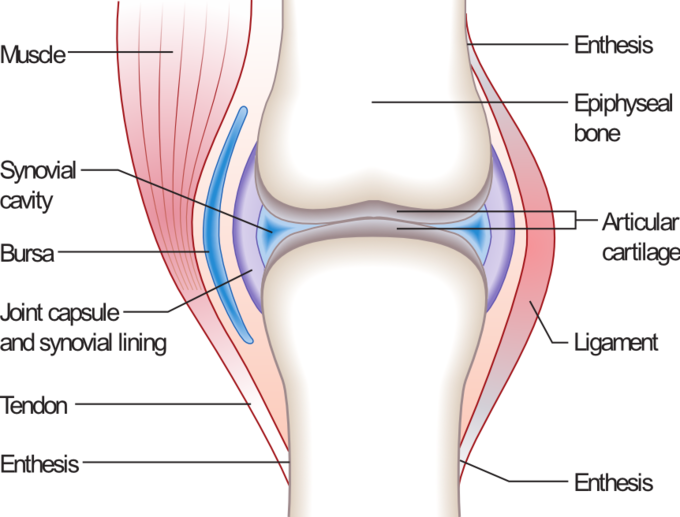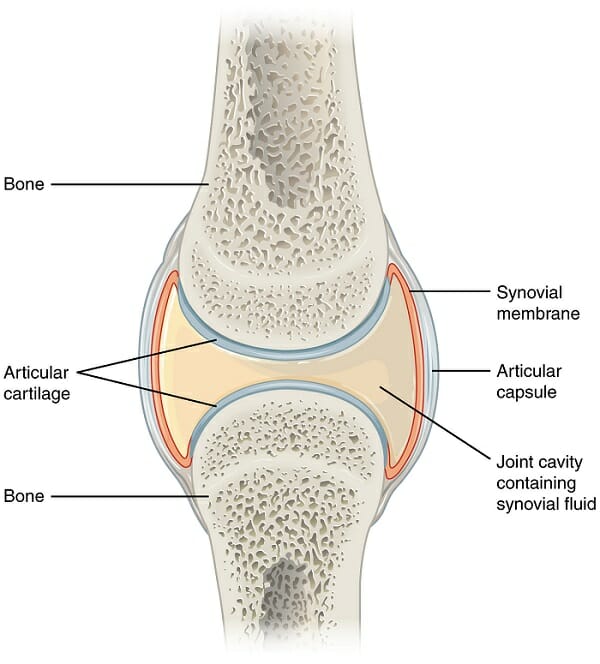Describe the Structure of a Synovial Joint Use This Description
It is one of the common type of joint seen in the body. Between the ribs and.

Structure And Function Of Synovial Joints Hsc Pdhpe
Because of the presence of a synovial membrane diarthrodial joints are frequently referred to as synovial joints.

. This fluid-filled space is the site at which the articulating surfaces of. Joints can be simply defined as articulations of bones which functions by providing shape to the skeleton system protects bones by holding them together securely and also helps in movement. Includes joints between the vertebral bodies and the pubic symphysis 3.
Based on structure and functions joints have been further classified into different types. Synovial Joint Definition. Typically allows a slight degree of movement 2.
The synovial cavityjoint is filled with. The six types of synovial joints are the pivot hinge saddle plane condyloid and ball-and. It consists of two layers.
A gliding joint also known as a plane joint or planar joint is a common type of synovial joint formed between bones that meet at flat or nearly flat articular surfaces. Diarthrosis joints are the most flexible type of joint between bones because the bones are not physically connected and can move more freely in relation to each other. Hinge joints operate just like the hinges on a door.
Key Structures of a Synovial Joint. A diarthrosis is an articulation that contains a fluid-filled joint cavity between two or more bones. I articular capsule ii articular cartilage iii synovial fluid.
The articular capsule surrounds the joint and is continuous with the periosteum of articulating bones. This problem has been solved. A fibrous joint is one in which the two articulating bones are interconnected by dense or fibrous connective tissue.
A synovial joint is a connection between two bones consisting of a cartilage lined cavity filled with fluid which is known as a diarthrosis joint. In synovial joints the ends of the bones are covered with cartilage called articular cartilage which cushions the joint and prevents friction and wear. Synovial joints are enclosed by a fibrous connective tissue capsule lined with a smooth synovial membrane.
A synovial joint is the type of joint found between bones that move against each other such as the joints of the limbs eg. These joints can be described as planar hinge pivot condyloid saddle or ball-and-socket joints. A key structural characteristic for a synovial joint that is not seen at fibrous or cartilaginous joints is the presence of a joint cavity.
Synovial fluid ordinarily clear transparent pale yellow and viscous is a plasma transudate derived from the subintimal capillary network and serves to nourish mature avascular cartilage and lubricate protect and regulate temperature within joints. Internally the fibrous capsule is lined with a. Bone cartilage synovium synovial fluid and tensile tissues composed of tendons and ligaments.
Other types of joint allow little or no movement including fibrous joints eg between the bones of the skull and cartilaginous joints eg. This gives the bones of a synovial joint the ability to move smoothly against each other allowing for increased joint mobility. The structure and function of synovial joints is our second dash point under the skeletal system.
At synovial joints the articular surfaces of bones are covered with smooth articular cartilage. Seven different categories of diarthrodial synovial joints exist each with unique functional abilities. Include details on tissue types that compose structures.
Describe the structure of the glenohumeral joint. Synovial joints are made up of five classes of tissues. Synovial joints allow for smooth movements between the adjacent bones.
The three main features of a synovial joint are. Next lets focus on hinge joints shown as letter B on the diagram. Characteristically it has a joint cavity filled with fluid.
Synovial joint is the joint that located between the bones which moves against each other. The articulating ends of bones in a synovial joint are covered with articular cartilage and are separated by a cavity that contains synovial fluid. Common accessory structures seen in synovial joints are.
The skeletal system has a number of different joint types for example there are fibrous joints and there are cartilaginous joints. Shoulder hip elbow and knee. The synovial lining in the bursae and tendon sheaths similar to that within joints is a slippery non-adherent surface allowing movement between planes of tissue.
You are allowed to ignore this though as you only need to know about the synovial joints which. Sutures are the most remembered examples 5. A synovial joint is one among the three types.
Include directional terms in your description. Hinge joints are the synovial joint type referred to in our introductory section. A synovial joint also known as diarthrosis joins bones or cartilage with a fibrous joint capsule that is continuous with the periosteum of the joined bones constitutes the outer boundary of a synovial cavity and surrounds the bones articulating surfaces.
All characterized by a fibrous articular capsule lined with a synovial membrane. Joints are formed where bones come together. The joint is surrounded by an.
The articulating bone ends are covered with articular cartilage and enclosed within and articular capsule which is typically reinforced by ligaments externally. Synovial joints are the most common type of joint in the body. Synovial joints are further classified into six different categories on the basis of the shape and structure of the joint.
This type of joints are mostly seen in limbs for example in hipknee and also in shoulder. This joint unites long bones and permits free bone movement and greater mobility. The shape of the joint affects the type of movement permitted by the joint Figure 1.
Characterized by cartilage connecting the bony portions 6. These joints can be found between your upper and lower arm bones otherwise called your elbow as well as your ankles fingers toes and knees. Figure 941 Synovial Joints.
General structure of a synovial joint. Essentially immovable joints 4. Hyaluronic acid in the fluid accounts for normal synovial fluids high viscosity.
Gliding joints allow the bones to glide past one another in any direction along the plane of the joint up and down left and right and diagonally. Articular cartilage coracohumeral ligament extracapsular ligaments glenohumeral ligaments glenoid cavity glenoid labrum head humerus.

Synovial Joint Structure Teachpe Com

Synovial Joint Diarthrosis Definition Types Structure Examples

Comments
Post a Comment